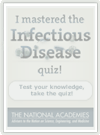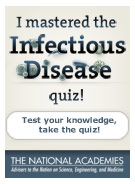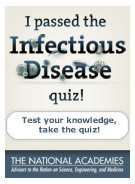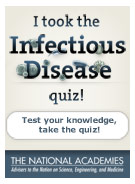
What You Need To Know About Infectious Disease
What do you know about infectious disease?
True or False: Thimerosal, a mercury-containing preservative that was used in some vaccines and other products, has been shown to present a risk to human health.
-
Sorry, that’s incorrect.
The use of thimerosal has been an object of controversy, with some arguing that the substance caused autism in children. However, extensive independent research has presented no convincing evidence of harm associated with the low levels of thimerosal previously present in vaccines.
-
Correct!
The use of thimerosal has been an object of controversy, with some arguing that the substance caused autism in children. However, extensive independent research has presented no convincing evidence of harm associated with the low levels of thimerosal previously present in vaccines.
Which of the following diseases is NOT caused by a virus?
-
Sorry, that’s incorrect.
Tuberculosis is caused by a bacterial infection. Chicken pox, the common cold, and influenza are all caused by viral infections.
-
Sorry, that’s incorrect.
Tuberculosis is caused by a bacterial infection. Chicken pox, the common cold, and influenza are all caused by viral infections.
-
Sorry, that’s incorrect.
Tuberculosis is caused by a bacterial infection. Chicken pox, the common cold, and influenza are all caused by viral infections.
-
Correct!
Tuberculosis is caused by a bacterial infection. Chicken pox, the common cold, and influenza are all caused by viral infections.
Which of the following global events does NOT have an impact on the spread of infectious disease:
-
Sorry, that’s incorrect.
The expanded use of cell phones does not have an impact on the spread of infectious disease. Climate change, ecosystem disturbances, war, poverty, migration, and global trade all contribute to the spread of infectious disease.
-
Correct!
The expanded use of cell phones does not have an impact on the spread of infectious disease. Climate change, ecosystem disturbances, war, poverty, migration, and global trade all contribute to the spread of infectious disease.
-
Sorry, that’s incorrect.
The expanded use of cell phones does not have an impact on the spread of infectious disease. Climate change, ecosystem disturbances, war, poverty, migration, and global trade all contribute to the spread of infectious disease.
-
Sorry, that’s incorrect.
The expanded use of cell phones does not have an impact on the spread of infectious disease. Climate change, ecosystem disturbances, war, poverty, migration, and global trade all contribute to the spread of infectious disease.
Each year, how many Americans become infected by what they eat?
-
Sorry, that’s incorrect.
Each year about 76 million Americans—or one in four—become infected by what they eat. Approximately 325,000 are hospitalized. More than 5,000 (14 a day) die.
-
Sorry, that’s incorrect.
Each year about 76 million Americans—or one in four—become infected by what they eat. Approximately 325,000 are hospitalized. More than 5,000 (14 a day) die.
-
Correct!
Each year about 76 million Americans—or one in four—become infected by what they eat. Approximately 325,000 are hospitalized. More than 5,000 (14 a day) die.
Which of the following is a bacterial infection?
-
Sorry, that’s incorrect.
Strep throat is a bacterial infection. Hookworm is caused by a parasite and chickenpox and influenza are both caused by viruses.
-
Sorry, that’s incorrect.
Strep throat is a bacterial infection. Hookworm is caused by a parasite and chickenpox and influenza are both caused by viruses.
-
Correct!
Strep throat is a bacterial infection. Hookworm is caused by a parasite and chickenpox and influenza are both caused by viruses.
-
Sorry, that’s incorrect.
Strep throat is a bacterial infection. Hookworm is caused by a parasite and chickenpox and influenza are both caused by viruses.
Which are examples of ways that pathogens (disease-causing microbes) can spread?
- Coughing
- Eating undercooked pork
- Flea bite
- Breathing dust particles containing microorganisms
- All of the above
-
Sorry, that’s incorrect.
All are examples of ways that pathogens can spread. Coughing is an example of airborne droplet transmission; eating undercooked pork is an example of common vehicle transmission; a flea bite is an example of vector transmission; and breathing contaminated dust particles is an example of airborne transmission.
-
Sorry, that’s incorrect.
All are examples of ways that pathogens can spread. Coughing is an example of airborne droplet transmission; eating undercooked pork is an example of common vehicle transmission; a flea bite is an example of vector transmission; and breathing contaminated dust particles is an example of airborne transmission.
-
Sorry, that’s incorrect.
All are examples of ways that pathogens can spread. Coughing is an example of airborne droplet transmission; eating undercooked pork is an example of common vehicle transmission; a flea bite is an example of vector transmission; and breathing contaminated dust particles is an example of airborne transmission.
-
Sorry, that’s incorrect.
All are examples of ways that pathogens can spread. Coughing is an example of airborne droplet transmission; eating undercooked pork is an example of common vehicle transmission; a flea bite is an example of vector transmission; and breathing contaminated dust particles is an example of airborne transmission.
-
Correct!
All are examples of ways that pathogens can spread. Coughing is an example of airborne droplet transmission; eating undercooked pork is an example of common vehicle transmission; a flea bite is an example of vector transmission; and breathing contaminated dust particles is an example of airborne transmission.
True or False: Scientists predict that rising average temperatures in some regions will change the transmission dynamics and geographic range of cholera, malaria, dengue fever, and tick-borne diseases.
-
Correct!
Scientists predict that rising average temperatures in some regions—a result of climate change—will change the transmission dynamics and geographic range of cholera, malaria, dengue fever, and tick-borne diseases.
-
Sorry, that’s incorrect.
Scientists predict that rising average temperatures in some regions—a result of climate change—will change the transmission dynamics and geographic range of cholera, malaria, dengue fever, and tick-borne diseases.
For each child who dies from pneumonia in an industrialized country, about how many children die from the infection in developing countries?
-
Sorry, that’s incorrect.
Life-saving vaccines and medications aren’t distributed equitably around the world; for each child who dies from pneumonia in an industrialized country, more than 2,000 children die from the infection in developing countries.
-
Sorry, that’s incorrect.
Life-saving vaccines and medications aren’t distributed equitably around the world; for each child who dies from pneumonia in an industrialized country, more than 2,000 children die from the infection in developing countries.
-
Sorry, that’s incorrect.
Life-saving vaccines and medications aren’t distributed equitably around the world; for each child who dies from pneumonia in an industrialized country, more than 2,000 children die from the infection in developing countries.
-
Correct!
Life-saving vaccines and medications aren’t distributed equitably around the world; for each child who dies from pneumonia in an industrialized country, more than 2,000 children die from the infection in developing countries.
Due in large measure to the toll of infectious diseases, the gap in life expectancy between the richest and poorest countries now exceeds how many years?
-
Sorry, that’s incorrect.
The gap in life expectancy between the richest and poorest countries now exceeds 40 years.
-
Sorry, that’s incorrect.
The gap in life expectancy between the richest and poorest countries now exceeds 40 years.
-
Correct!
The gap in life expectancy between the richest and poorest countries now exceeds 40 years.
-
Sorry, that’s incorrect.
The gap in life expectancy between the richest and poorest countries now exceeds 40 years.
Thank you for taking our quiz.
Place this badge on your Facebook page to show your friends what you know about infectious disease.
Place this badge on your Facebook page to show your friends what you know about infectious disease.
OR, get a higher score to unlock a different badge.

Place this badge on your Facebook page to show your friends what you know about infectious disease.
OR, get a higher score to unlock a different badge.

Explore Other Topics
Disease Watchlist
Infectious Disease Defined
- Gene
The physical and functional unit of heredity made up of DNA. Every individual has two copies of each gene, one inherited from the mother and the other from the father.


